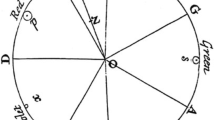Abstract
Translations of Schrödinger’s articles on color theory show us the continuing importance of his colorimetry. Schrödinger’s color theory develops a tradition which begins with Newton, and which was developed by Helmholtz and by Grassmann. Schrödinger also wrote at a time when Fechner’s influence on psychology was much stronger than it is now. Some colorimetric terms have changed since his articles were published: some are more precisely applied than general terms were in the 1920s. There have also been surprises since, such as Wald’s discovery of small-field tritanopia, and the discovery of four-cone color systems in some women. Generally Schrödinger’s approach to color theory is sophisticated, comprehensive, and usefully didactic. His axiomatic approach to the geometry of color space permits a close examination of current assumptions about the treatment of data from color matching and color comparison.
Similar content being viewed by others
Author information
Authors and Affiliations
Editor information
Editors and Affiliations
Rights and permissions
Copyright information
© 2017 Springer International Publishing AG
About this chapter
Cite this chapter
Niall, K.K. (2017). Schrödinger’s Color Theory and Its Background. In: Niall, K. (eds) Erwin Schrödinger's Color Theory. Springer, Cham. https://doi.org/10.1007/978-3-319-64621-3_1
Download citation
DOI: https://doi.org/10.1007/978-3-319-64621-3_1
Published:
Publisher Name: Springer, Cham
Print ISBN: 978-3-319-64619-0
Online ISBN: 978-3-319-64621-3
eBook Packages: Physics and AstronomyPhysics and Astronomy (R0)




